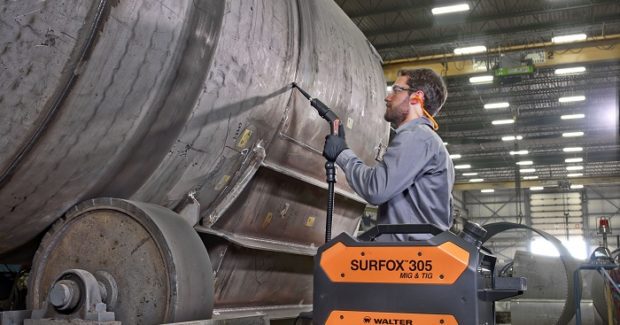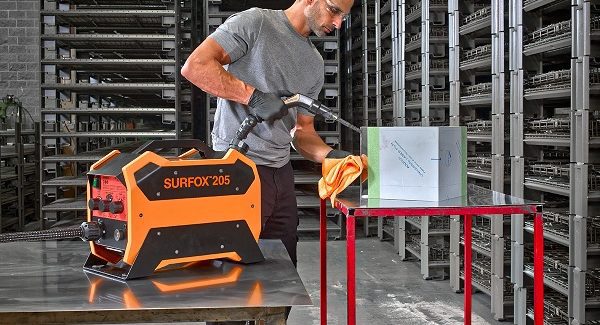Electro-Chemical Weld Cleaning: It Makes More Sense
Where stainless steel and aluminum is concerned, there has been a drift away from traditional wire brushes and harsh chemical cleaning solutions in favor of more efficient, environment-friendly electrochemical weld cleaning technologies that make more economic and safety sense than other costlier, traditional and sometimes toxic methods.
Posted: April 11, 2018
I’m often asked if there are any “trends” in TIG, MIG or spot welding cleaning applications. My answer is always the same: fabricators want products that help them work better. They want to lower their costs, drive up productivity and improve quality. Earlier this year, for example, when we introduced our fifth-generation Surfox 305™ electrochemical weld cleaning system for stainless steel and aluminum, we had heavy-production, high volume metal fabrication shops in mind . . . that, and organizations with a need for quality and safety. That system has been helping metalworkers in stainless steel applications that need to achieve passivation, as well as clean welds fast. Where aluminum is concerned, there’s been a drift away from traditional wire brushes and harsh chemical cleaning solutions in favor of more efficient, environment-friendly electrochemical technologies.
We’ve known for years of the predominance of aluminum in aerospace applications, and today the automotive sector has a strong appetite for this lightweight alloy. The pre- and post-welding challenges that are commonly found in steel fabrication are now just as prevalent in the daily welding operations of aluminum fabricators. As weld cleaners go, wire brushes are fast, but they scratch soft alloys like aluminum and alter their finish. Strong chemicals can clean welds but, depending on their type, can also cause surface damage. Health hazards and expensive disposal issues also come into play. An electrochemical weld cleaning system uses a safe and pH-neutral solution that won’t damage stainless steel or aluminum. This is why we are committed to electrochemical cleaning technologies in this area, as well as pre-weld practices that give users more bang for their cleaning buck.
Welding aluminum poses unique challenges: Defects such as discoloration, weld smut, cracking and porosity are common concerns. On a fresh aluminum weld, it’s not uncommon to see the presence of black oxide – a residue that needs to be cleaned. In MIG, TIG or spot weld operations, chances are that heat tint on heat-affected zones will emerge, which is another cleaning problem. Pre-weld issues, such as the risk of surface contaminants, are also common. Impurities of this nature – oil, rust and paints – cause weld spatter, which is why it’s vital to clean surfaces as best as possible prior to welding. Fabricators covet fast cleaning processes that won’t alter surfaces, but they must be effective. So when shops consider electrochemical weld cleaning, we encourage them to review their welding processes in totality. The goal is to optimize their pre-weld preparations to get better welds, and their post-weld operations to get cleaner welds. The better the weld, the less cleaning it will need.
An electrochemical weld cleaning system will clean a weld at a rapid rate of three to five feet per minute. The electrochemical device uses a pH-neutral electrolyte solution that is pumped directly to the surface being cleaned, and a dynamic electrical current control prevents micro-pitting on weld surfaces. In fact, our Surfox 305 is the industry’s fastest MIG and TIG weld cleaning system. Compared with toxic pickling pastes that require at least an hour of application prior to removal, it’s easy to see the advantages of non-toxic electrochemical cleaning. Pickling of stainless steels, for example, involves strong acidic solutions of nitric and hydrofluoric acids. You have to apply the paste, wait an hour for it to work, and then rinse it off the metal. Costly environmental compliance measures come into play if special wastewater disposal techniques are required, which usually are with toxic acids. Indeed, some fabricators pay as much as $8 per liter to dispose of pickling paste and associated liquids. It’s not cheap.
The beauty of electrochemical cleaners lies in their eco-friendly technology: Once a weld is cleaned, residue can simply be wiped off. The electrolyte solution is not considered a dangerous liquid. It’s phosphorus-based so there’s no added cost for disposal. Of course, there’s an initial capital investment because you have to pay for the machine. Brushes are about $50 dollars each and last eight to ten hours, so you have to factor that in. The liquid is inexpensive, running about $3 per day for a busy shop. Moving to an electrochemical cleaning solution offers an additional advantage of optimizing welding processes. If you’re going to electrochemically clean a weld, you want to clean a good weld for the simple reason that a bad weld is harder to clean, so a refresh of best-practice welding processes is beneficial in more ways than one:
- Incorrect equipment amperages or voltages and poor-quality shielding gases can contribute to poor welds.
- Welding at the wrong angle is problematic, and the jury is still out on whether pushing or dragging in MIG welding is best.
- It’s vital to optimize welding equipment parameters.
- Always use high quality filler material, free of impurities. Cheap filler materials have impurities that tend to settle on top of welds. They’re hard to clean. They look bad. And they slow cleaning.
When cleaning, always use enough electrolyte solution so as not to burn your cleaning brush or pad. If you burn your brush, carbon-fiber bristle could stick to the surface and require re-cleaning. When cleaning TIG welds, which are typically nice welds, Surfox 205™ is ideal. For MIG welds, with harder-to-clean automatic filler materials, look to the more powerful 305. The Surfox Mini™, meanwhile, is ideal for field work and small repair jobs. Either way, electrochemical weld cleaning makes more economic, environmental and safety sense than other costlier, traditional and sometimes toxic methods.


















